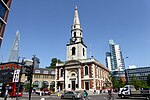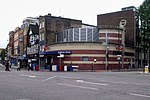Resonance FM

Resonance 104.4 FM is a London based non-profit community radio station specialising in the arts run by the London Musicians' Collective (LMC). The station is staffed by four permanent staff members, including programme controller Ed Baxter and over 300 volunteer technical and production staff. Until September 2007, its studios were located on Denmark Street before moving to its present location at 144 Borough High Street, Southwark. The station broadcasts to a three-mile (4.8 km) radius on 104.4 MHz FM from a transmitter on the roof of Guy's Hospital at London Bridge. Its schedule includes nearly 100 shows catering to many sub-communities of the London area on a wide variety of subjects including a multitude of musical genres, local and foreign current affairs and subjects of local interest. Noted for its policy of giving broadcasters free rein of their creative outlet, it has been described by Time Out as "brilliantly eccentric". The station receives funding grants from Arts Council England.
Excerpt from the Wikipedia article Resonance FM (License: CC BY-SA 3.0, Authors, Images).Resonance FM
Borough High Street, London Borough (London Borough of Southwark)
Geographical coordinates (GPS) Address Nearby Places Show on map
Geographical coordinates (GPS)
| Latitude | Longitude |
|---|---|
| N 51.502777777778 ° | E -0.0925 ° |
Address
Maple Building
Borough High Street 128
SE1 1HR London, Borough (London Borough of Southwark)
England, United Kingdom
Open on Google Maps









